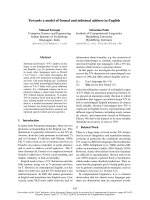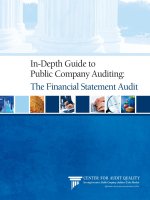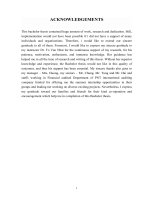Completing the audit of the item revenue from sales of merchandises and serviecs rendered in the financial statement audit at branch auditing and informatic
Bạn đang xem bản rút gọn của tài liệu. Xem và tải ngay bản đầy đủ của tài liệu tại đây (1.72 MB, 87 trang )
DUY TAN UNIVERSITY
INTERNATIONAL SCHOOL
UNDERGRADUATE THESIS
COMPLETING THE AUDIT OF THE ITEM REVENUE
FROM SALES OF MERCHANDISES AND SERVIECS
RENDERED IN THE FINANCIAL STATEMENT AUDIT
AT BRANCH AUDITING AND INFORMATICS
SERVICES COMPANY LIMITED IN DA NANG (AISC).
@
MENTOR
: Ph.D PHAN THANH HAI
STUDENT
: HUYNH THI ANH NGUYET
CLASS
: K23PSUKKT1
ID
: 2320257535
Da Nang, May 2021
ACKNOWLEDGEMENT
First, I would like to thanks sincerely to the teachers of International
School in Duy Tan University who help me to quip the necessary knowledge
and convenient environment in time learning as well as time of graduation
thesis.
I would like to express my gratitude to my supervisor, MBA. Nguyen Thi
Kim Huong who was helped me from the select topics to gudie the way,
content to do all. Thanks to her support, so I could complete thesis on time
stipulated.
I would also like to thanks all employees of the Branch Auditing and
Informatics Services Company Limited in Danang. Especially, the auditors of
financial statement audit department who has directly guided, created an
opportunity for me to be practiced in the company, provides information and
data relevant to research topic, help me have more knowledge throughout
practices process.
Because knowledge and practice time in the company limited, the thesis
can not avoid these shortcomings. I hope to receive comments and critics of
teachers and brothers, sisters in the company to improve my thesis.
Last, I wish teacher and all employees of the Branch Auditing and
Informatics Services Company Limited in Danang (AISC) good health,
success in work.
I sincerely thanks you!
TABLE OF CONTENTS
ABSTRACT......................................................................................................1
INTRODUCTION............................................................................................2
CHAPTER 1. THEORETICAL BASIS FOR THE AUDIT OF REVENUE
FROM SALES OF MERCHANDISES AND SERVICES RENDERED
ITEM IN AUDITING FINANCIAL STATEMENTS UNDER THE
SAMPLE AUDIT PROVIDED BY VACPA..................................................5
1.1. BASIC ISSUES RELATED TO REVENUE FROM SALES OF
MERCHANDISES AND SERVICES............................................................5
1.1.1. General overview of the revenue from sales of merchandises and
services rendered item.....................................................................................5
1.2. REVENUE FROM SALES OF MERCHANDISES AND SERVICES
RENDERED ON AUDITING FINANCIAL STATEMENTS.....................8
1.2.1. Internals control for revenue from sales of merchandises and services
rendered audits...................................................................................................8
1.2.2. Common risks and mistakes when auditing Revenue from sales of
merchandises and services rendered..................................................................8
1.3. CURRENTLY AUDITING THE REVENUE FROM SALES OF
MERCHANDISES AND SERVICES RENDERED PROGRAM UNDER
VACPA SAMPLE AUDIT PROGRAM......................................................10
1.3.1. Profile index...........................................................................................10
1.3.2. Audits content of Revenue from sales of merchandises and services
rendered item....................................................................................................10
CHƯƠNG 2. AUDITING SITUATION OF REVENUE FROM SALES
OF MERCHANDISES AND SERVICES RENDERED ITEM IN
AUDITING FINANCIAL STATEMENTS PERFORMED BY BRANCH
AUDITING AND INFORMATICS SERVICES COMPANY LIMITED
IN DA NANG..................................................................................................26
2.1. OVERVIEW OF BRANCH AUDITING AND INFORMATICS
SERVICES COMPANY LIMITED IN DA NANG....................................26
2.1.1. Introduction about Branch Auditing and Informatics Services Company
Limited in Da Nang..........................................................................................26
2.1.2. The formation and development process of Branch Auditing and Informatics26
2.1.3. Operational objective, strategic vision of the company.........................27
2.1.4. Types of services provided by the company:.........................................28
2.1.5. Organization structure of AISC..............................................................34
2.2.
STATUS OF AUDITING ON REVENUE FROM SALES OF.......36
MERCHANDISES AND SERVICES RENDERED IN THE AUDITING
OF
FINANCIAL
STATEMENTS
PERFORMED
BY
BRANCH
AUDITING AND INFORMATICS SERVICES COMPANY LIMITED
IN DA NANG..................................................................................................36
2.2.1. Audit planning phase..............................................................................36
2.2.2. Audit implementation phase...................................................................42
2.2.3. The end of the audit period....................................................................59
CHAPTER 3. SOLUTIONS FOR COMPLETING THE AUDIT
PROCESS FOR REVENUE FROM SALES OF MERCHANDISES AND
SERVICES RENDERED IN AUDITING FINANCIAL STATEMENTS
AT
BRANCH
AUDITING
AND
INFORMATICS
SERVICES
COMPANY LIMITED IN DA NANG.........................................................65
3.1. COMMENTS ON AUDITING PROCESS ON REVENUE FROM
SALES OF MERCHANDISES AND SERVICES RENDERED ITEMS
AT X JOINT STOCK COMPANY BY BRANCH AUDITING AND
INFORMATICS SERVICES COMPANY LIMITED IN DA NANG......65
3.1.1. General comment...................................................................................65
3.1.2 . Advantages............................................................................................65
3.1.3. Disadvantages........................................................................................67
3.2. SOLUTIONS TO COMPLETE THE AUDITING PROCESS ON
REVENUE FROM SALES OF MERCHANDISES AND SERVICES
RENDERED
BY
BRANCH
AUDITING
AND
INFORMATICS
SERVICES COMPANY LIMITED IN DA NANG....................................68
3.2.1. Audit planning phase..............................................................................68
3.2.2. Audit implementation phase...................................................................71
3.2.3. End of the audit period:..........................................................................74
3.3. SOME RECOMMENDATIONS FOR BRANCH AUDITING AND
INFORMATICS SERVICES COMPANY LIMITED IN DA NANG......74
CONCLUDE...................................................................................................76
LIST OF REFERENCES
LIST OF ABBREVIATIONS
AISC
Branch Auditing snd Informatics Services Company
Limited in Da Nang
VACPA
Vietnam Association of Certified Public Accounts
LIST OF TABLES
Table
Trang
Table 2.1 Description of the process of selling and providing services
38
Table 2.2 Determine materiality
42
Table 3.1 Evaluate the internal control system for revenue from sales of
70
merchandises and services rendered item
LIST OF FIGURES
Diagram
Trang
Figure 2.1 Organizational Structure of AISC
34
Figure 2.2 Organizational Structure of AISC-Da Nang Branch
34
ABSTRACT
The topic of thesis focuses on revenue from sales of merchandises and services
rendered audit at Branch Auditing snd Informatics Services Company Limited in Da
Nang (AISC). In the financial statement audit process, revenue from sales of
merchandises and services rendered is a very important item which can have many
errors. That is the reason why the auditing revenue from sales of merchandises and
services rendered become complex and time- consumed. Not only using the detail
steps are described in the auditing revenue from sales of merchandises and services
rendered at AISC, the thesis also focuses on some other steps to build a perfect
inventory auditing process for the company. Thesis consists of three chapters:
Chapter 1: Theoretical basis for the audit of revenue from sales of
merchandises and services rendered item in auditing financial statements
under the sample audit provided by VACPA
This chapter focused on the following issues: learn about revenue from
sales of merchandises and services rendered item, process audit item of
revenue from sales of merchandises and services rendered in the audit of
financial statements.
Chapter 2: Auditing situation of revenue from sales of merchandises
and services rendered item in auditing financial statements performed by
Branch Auditing and Informatics Services Company Limited in Da Nang
Research the following issues: Learn about by Branch Auditing and
Informatics Services Company Limited in Danang, process revenue from sales
of merchandises and services rendered audit in financial statement performed
by the company.
Chapter 3: Some recommendations for Branch Auditing and
Informatics Services Company Limited in Da Nang.
Although the process revenue from sales of merchandises and services
rendered audit have many advantages, there also have many disadvantages.
Therefore, I would like to make some suggestions for AISC to complete
process revenue from sales of merchandises and services rendered audit in the
financial statement audit.
1
INTRODUCTION
1.Reasons for choosing a research topic
Along with the rapid development of science and technology today, the
world economy is step by step going up strongly. Along with that
development, Vietnam's economy also has positive changes. An inevitable
requirement is that businesses must disclose their financial position to create
confidence for investors and take advantage of economic resources. Auditing,
as a tool to check and control economic activities, has demonstrated its
function in verifying the truthfulness and accuracy of financial information.
In the financial statement audit process, information about revenue
from sales of merchandises and services rendered particularly concerned about
sales and service provision that contain many possible fraud risks and errors.
Because of the importance of the revenue portion in the audit of financial
statements, I chose the topic, “Completing the audit of revenue from sales of
merchandises and services rendered in auditing financial statements at Branch
Auditing and Informatics Services Company Limited in Da Nang (AISC)“
doing the research topic and write the graduation thesis.
2.Research Objectives
- From research to find out the general theoretical basis as a basis for the
implementation of the process revenue from sales of merchandises and
services rendered audit
- To actually experience the process of implementing the revenue from
sales of merchandises and services rendered from there as a basis, lessons,
and experience in the implementation of other items during the complete audit.
- Thereby, I can draw lessons, learn from experience, skills, draw
advantages and disadvantages, propose some solutions to help improve the
process of revenue from sales of merchandises and services rendered audit.
3. Research methods
During the study of thesis use methods such as:
2
Data collection method
Gathering documents, sample processes and related records to revenue
from
sales of merchandises and services rendered audit process in financial
statement auditing at Branch Auditing and Informatics Services Company in
Danang.
Collect data from records, economic magazine related to inventory at X
Company.
Directly participate the auditing team of Branch Auditing and
Informatics
Service Co., Ltd in Danang.
Collected working papers and auditing reports audited by the auditors
of
Branch Auditing and Informatics Service Co., Ltd in Danang for checking
inventory items at XYZ company.
Data processing method
Using Microsoft Excel to calculate, process and analyze customer
accounts
data after collection.
Repeat the audit procedures that the auditor has conducted to
understand and
grasp specific methods and procedures.
Interviewing method: collect the necessary information through
interviews
with employees at the client company or discuss with the auditor about the
issue.
4.Structures of the study
Theses consist of three chapters:
3
Chapter 1: Theoretical basis for the audit of revenue from sales of
merchandises and services rendered item in auditing financial statements
under the sample audit provided by VACPA.
Chapter 2: Auditing situation of revenue from sales of merchandises
and services rendered item in auditing financial statements performed by
Branch Auditing and Informatics Services Company Limited in Da Nang.
Chapter 3: Some recommendations for Branch Auditing and
Informatics Services Company Limited in Da Nang.
4
CHAPTER 1
THEORETICAL BASIS FOR THE AUDIT OF REVENUE FROM
SALES OF MERCHANDISES AND SERVICES RENDERED ITEM
IN AUDITING FINANCIAL STATEMENTS UNDER THE
SAMPLE AUDIT PROVIDED BY VACPA
1.1. BASIC ISSUES RELATED TO REVENUE FROM SALES OF
MERCHANDISES AND SERVICES
1.1.1. General overview of the revenue from sales of merchandises and
services rendered item
1.1.1.1. Concept
According to the accounting standard No.14 (VAS 14) "Revenue and
other income" in the Vietnamese accounting standards system, "Revenue is the
total value of economic benefits earned by the business in the accounting
period, arising from normal production and business activities of the
enterprise, contributing to the development of equity."
1.1.1.2. Classify
Revenue classification by content, revenue includes:
Revenue from sales of merchandises is the sales of products that an
enterprise produces, sells goods purchased and sells investment properties.
Revenue from services rendered is the revenue from performing works
agreed upon under a contract in one or more accounting periods such as the
provision of transport services, tourism, and the lease of fixed assets under the
mode of operating lease moving.
Revenue from internal sales is the revenue of the number of products,
goods and services consumed internally, is the economic benefit obtained
from the internal sale of goods, products, and services among dependent
accounting units in the same company, the corporation is calculated according
to the internal selling price.
5
Revenue from financial activities is income from interests, royalties,
dividends, distributed profits and other revenues from financial activities of
the enterprise.
1.1.1.3. Characteristics
On the financial statements, Net revenue from sales of merchandises and
services rendered is presented in item 1, Code 01 on income statement
according to form B 02-DN (Issued under Circular 200/2014 / TT -BTC,
December 22, 2014, of the Ministry of Finance), including revenue from sales
of merchandises and services rendered, revenue deductions and net revenue.
Accordingly, there are specific targets which are construed as follows:
- Revenue from sales of merchandises and services rendered: This is the
indicator of sales and services rendered and internal revenue when shown on
income statement. Revenue from sales of merchandises and services rendered
are the revenue earned from the sale of products produced by the enterprise,
the sale of purchased goods and investment property ... including subsidies
and subsidies that the enterprise inherit. For enterprises that are subjected to
value added tax by the deduction method, this enterprise does not include
value added tax.
- Revenue deductions:
Trade discount (5211): is the amount where a business sells off listed
prices
to customers who buy goods in large volume.
Sales returned (5212): Is the value of sales volume determined as
consumption returned by the customer and refused to pay.
Sales discount (5213): Is a deduction for buyers due to poor quality,
incorrect specifications or outdated tastes
- Net revenue from sales of merchandises and services rendered: this
index reflects the sales of goods, finished goods and service provision minus
deductions (trade discounts, sales discounts ...) in the period report, as a basis
for calculating the business results of the enterprise.
6
1.1.1.4. Role
Revenue from sales of merchandises and services rendered is an
important
financial source of the business, helping businesses pay costs incurred in
production and business activities. This is the financial source that determines
the operation of the enterprise in the next accounting period.
When businesses carry out sales on a regular basis, it will increase the
capital flow rate, increase capital turnover. Facilitating efficient use of capital,
reducing costs of external borrowing for businesses.
Is an important basis for determining business results in the period,
helping
enterprises to easily fulfill their obligations to the State.
Increasing revenue means to increase the amount of money earned
while
increasing the number of goods sold, this shows that the business has created a
certain position in the market. In a sense, the increase in revenue means that
the profits of the business also increase accordingly. Therefore, it requires
businesses to manage sales and provide services effectively.
1.1.1.5. How to make the item of revenue from sales of merchandises and
services rendered on the financial statements
Debit Party
Credit Party
- Indirect taxes payable (Value-Added
-
Sales
of
products,
Tax, Excise Tax, export tax,
investment properties and services
Environment tax);
rendered by the enterprise in the
- Revenue deductions;
accounting period
- Transfer net revenue to 911 account
"Determination of business results"
Account 511 does not have a closing balance
7
goods,
1.2. REVENUE FROM SALES OF MERCHANDISES AND SERVICES
RENDERED ON AUDITING FINANCIAL STATEMENTS
1.2.1. Internals control for revenue from sales of merchandises and
services rendered audits
The auditor uses the assessment of the internal control system of the
customer and the audit risk assessment of revenue from sales of merchandises
and services rendered to interview the client. On that basis, make a conclusion
about the entity's internal control system. Inspection of internal control
systems is recommended for use in the following cases:
• The control procedure is expected to be effective
• Basic testing procedures cannot reduce the risk of material
misstatement to
an acceptable level due to too many operations occurring, small value, or
being controlled by the information technology system.
On the basis of the results of the sampling test, the auditor concludes that
he believes in the tested primary control procedure? If you do not trust the
internal control system, the auditor will have to perform a high level of basic
inspection. Conversely, the basic test can only be performed in the medium or
low level.
1.2.2. Common risks and mistakes when auditing Revenue from sales of
merchandises and services rendered
Revenue from sales of merchandises and services rendered is considered
an important indicator to evaluate the business and production situation of the
business. Therefore, this indicator has many potential errors and frauds. With
the purpose of "beautifying" financial statements to attract investment capital
of shareholders in the stock market, listed companies and businesses often use
fraudulent techniques in preparing financial statements, specifically. Common
mistakes are as follows:
Revenue and income reflected in records and accounting report are
higher than the actual revenue and income:
8
In this case, it is specifically shown that revenue has been recognized as
revenue or income in the business results while not meeting the conditions for
recording revenue and income as prescribed in the standard. Or the amount of
revenue or income reflected on records is higher than the actual revenue.
For example, the incorrect recognition of revenue in the following cases:
Revenue counterfeiting: recording unrealistic revenue in records. Forms
of
counterfeiting revenue such as making transactions with fake customers or
making fake invoices with real customers but in fact goods and services are
not delivered. At the beginning of next year, the revenue was still reversed to
conceal this fraud.
Early recognition of revenue: when the revenue recognition conditions
are
not met, such as the goods have not been delivered to the customer or only
partially delivered and the customer has not agreed to pay. Or early revenue in
the case of a sale contract with a term attached. In fact, the terms of the
contract are incomplete, and the rights and risks of ownership of the goods
have not been transferred to the purchaser. Many businesses, when exporting
goods and services to customers for trial, have recorded revenue. This form of
revenue recognition is considered recognizing revenue at the wrong time when
future contracts terms have not been fulfilled.
Duplicate revenue and income accounting
Wrongly calculated and recorded data increased revenue and income
compared to the data reflected on the accounting vouchers.
Revenue and income reflected in records and accounting report are
lower
than actual revenue and income:
This case is expressed specifically that the enterprise has not fully
recognized
the revenues and incomes in the business results in the period even though it
meets the conditions to be determined as revenue or income as prescribed in
9
the standard. Or the amount of revenue or income reflected on the report is
lower than the revenue on the arising accounting vouchers.
Example: An enterprise does not account for a lack of revenue in the
following
cases:
The enterprise has made sales procedures and services rendered to the
customer, the customer has paid or accepted the payment but the enterprise
has not recorded the revenue. Or have mistakenly booked revenue into another
account.
Revenue from financing activity and other income earned but the
enterprise
has not yet recorded or recorded to other accounts.
The incorrectly calculated and recorded data has reduced revenue and
income compared with the data reflected on the accounting vouchers.
1.3. CURRENTLY AUDITING THE REVENUE FROM SALES OF
MERCHANDISES AND SERVICES RENDERED PROGRAM UNDER
VACPA SAMPLE AUDIT PROGRAM
1.3.1. Profile index
Include as follows:
G110
G120
G130
Summary table of data
Working paper for Notes to the financial statements
Audit program - revenue from sales of merchandises and services
rendered
Summary of audit results
Summary table of detailed business results
G131
G141
1.3.2. Audits content of Revenue from sales of merchandises and services
rendered item
CƠNG TY
Tên khách hàng:
Ngày kết thúc kỳ kế tốn:
Nội dung: CHƯƠNG TRÌNH KIỂM TỐN - DTBH&CCDV
I.
MỤC TIÊU KIỂM TỐN
10
Cơ sở dẫn liệu
1
Đảm bảo doanh thu liên quan tới các nghiệp vụ bán hàng đã thực
hiện hoặc/và dịch vụ đã cung cấp .
2
Đảm bảo doanh thu từ các sản phẩm, hàng hóa đã bán và dịch vụ
đã cung cấp được ghi nhận chính xác và phân loại phù hợp.
3
Đảm bảo giá trị doanh thu được phản ánh trên Báo cáo
KQHĐKD không bao gồm các khoản thuế gián thu (thuế xuất
nhập khẩu, thuế tiêu thụ đặc biệt, thuế GTGT nộp theo phương
pháp trực tiếp).
A/Tính chính xác
4
Đảm bảo tồn bộ các khoản giảm trừ doanh thu (chiết khấu
thương mại, giảm giá hàng bán và hàng bán bị trả lại) được ghi
nhận chính xác.
O, C, A/Tính hiện hữu,
tính đầy đủ, tính chính xác
5
Đảm bảo doanh thu ghi nhận đúng kỳ.
6
Đảm bảo tất cả các thuyết minh cần thiết liên quan đến doanh thu
bán hàng và cung cấp dịch vụ được lập chính xác và các thơng tin
này được trình bày và mơ tả phù hợp trong BCTC.
II.
O/Tính hiện hữu
C,A, Classification/Tính
đầy đủ, Tính chính xác,
phân loại
Cut-off/ Đúng kỳ
P&D/Trình bày và
thuyết minh
RỦI RO Ở CẤP ĐỘ CƠ SỞ DẪN LIỆU
Từ kết quả của phần lập kế hoạch [tham chiếu các giấy làm việc tại phần A800] , xác định
mức độ rủi ro theo từng cơ sở dẫn liệu của khoản mục (chi tiết theo TK được kiểm tra của
khoản mục) vào bảng dưới đây:
Cơ sở dẫn liệu
O/Tính
hiện
hữu
C/Tính
đầy đủ
A/Tính
chính
xác
Cutoff/Đúng
kỳ
Classification
/Phân loại
P&D/Trình
bày và
thuyết minh
Rủi ro ở cấp độ
cơ sở dẫn liệu
(Thấp/Trung
bình/Cao)
III.
XEM XÉT BIỆN PHÁP XỬ LÝ KIỂM TỐN
III.1. Rủi ro có sai sót trọng yếu của khoản mục
Rủi ro có sai sót trọng yếu của khoản mục và biện pháp xử lý kiểm toán đề xuất được lấy
từ các giấy làm việc tại phần A800. Nếu phát hiện các rủi ro có sai sót trọng yếu khác
trong q trình kiểm tốn, KTV cần cập nhật các giấy làm việc tại phần A800 và bảng này:
Các rủi ro có sai sót trọng yếu
Cơ sở dẫn liệu bị ảnh hưởng
11
Ghi thủ tục kiểm toán (*)
(*) Lưu ý: Đối với các rủi ro cụ thể như rủi ro đáng kể, rủi ro gian lận,… KTV phải thiết kế
các thủ tục phù hợp để xử lý các rủi ro cụ thể này bằng cách sửa đổi các thủ tục nêu tại mục
III.2 hoặc bổ sung thủ tục ngoài các thủ tục nêu tại mục III.2 (KTV có thể tham khảo thư viện
các thủ tục kiểm tốn bổ sung trong CTKTM - BCTC 2019).
III.2. Thử nghiệm cơ bản (áp dụng cho tất cả các nhóm giao dịch, số dư TK và thông
tin thuyết minh trọng yếu)
Lưu ý: Đối với thử nghiệm cơ bản, xem xét các câu hỏi gợi ý dưới đây (bao gồm nhưng
không giới hạn) để thiết kế, lựa chọn các thủ tục kiểm toán thích hợp khi trả lời “Có”. Khi
đó KTV sẽ xem xét lựa chọn, sửa đổi/bổ sung hoặc loại bỏ các thủ tục kiểm tốn tương
ứng với bước đó tại CTKiT.
Có
1.
Khơng
Ý kiến
Bước B
Giá trị của khoản mục này có trọng yếu (Giá trị khoản mục lớn hơn mức trọng yếu thực
hiện) hoặc dự kiến là trọng yếu tại ngày kết thúc kỳ kế tốn khơng?
Có các loại doanh thu khác nhau được ghi nhận theo chính sách ghi nhận doanh thu
khác nhau khơng?
Có hợp đồng nào với nhiều nghĩa vụ thực hiện khơng?
Có các ước tính và xét đốn quan trọng nào được yêu cầu trong ghi nhận nhận doanh thu
trong kỳ khơng?
2.
Bước C
Giá trị của khoản mục này có trọng yếu (Giá trị khoản mục lớn hơn mức trọng yếu thực
hiện) hoặc dự kiến là trọng yếu tại ngày kết thúc kỳ kế tốn khơng?
Có các giao dịch trọng yếu với bên liên quan trọng yếu khơng?
3.
Bước D
4.
Có sẵn những thông tin phù hợp và tin cậy để cho KTV xây dựng ước tính giá trị doanh
thu kỳ vọng và so sánh với giá trị doanh thu đã ghi nhận khơng?
Bước E
5.
Có những giao dịch bằng tiền mặt lớn khơng?
Bước F
Có phát sinh sai sót trọng yếu liên quan đến tính đúng kỳ được dự kiến tại ngày kết thúc
kỳ kế tốn khơng?
12
Có
6.
Ý kiến
Bước G
7.
IV.
Khơng
Hàng bán bị trả lại dự kiến có trọng yếu khơng?
Bước K
Có bất kỳ sự khơng tn thủ nào khn khổ lập và trình bày BCTC được áp dụng trong
các kỳ trước khơng?
Có bất kỳ thay đổi nào trong các chính sách kế tốn trong kỳ khơng?
Có các ước tính và xét đốn quan trọng nào được u cầu trong ghi nhận nhận doanh thu
trong kỳ không?
KẾT LUẬN LẬP KẾ HOẠCH
Theo ý kiến của tôi, từ các thủ tục được lập kế hoạch, các bằng chứng kiểm toán đầy đủ và
thích hợp có thể được thu thập để đạt được các mục tiêu kiểm toán.
Người lập:
Ngày:
Người soát xét 1:
Ngày:
Người soát xét 2:
Ngày:
13









